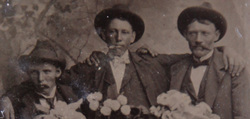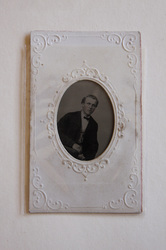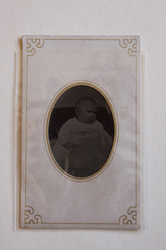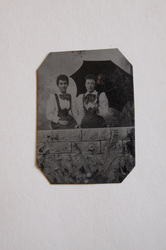 Following up yesterdays post on tintypes, I thought I would share this small collection of tintypes I picked up in Tea, SD back in January. They were sold as a lot of 6. These are among the smaller tintypes in my collection but they are all set within an embossed paper/cardboard frame. While none of these are have any real rarity to them, I did like the various framing on the pieces. You can see that the photos are in a plastic protective sleeve...ones that I have borrowed from my baseball card collection that is still hanging around. My goal in collecting these objects is to one day use them in a history of photography class to discuss the early photographic processes and how photography impacted the general populace, rather than simply focus on the fine art component.
0 Comments
 Of the thousands of vintage photos that I have collected, the tintypes are among my favorite. Today Ive included a small gallery of a few of my collection. I am perpetually astounded by the quality of some of the images...how sharp they are...the beautiful depth of field in some. For an early process, they are remarkable. The size variation is always interesting as well. Not many are more than 2x3 but many are 1x2. I think this variation is at the heart of my love for vintage photography against the standardized formats that I grew up with. Enjoy.  This is one of my favorite photo pieces. After you examine enough historical photos and a little more research, you begin to recognize certain motifs that seem to pop up again and again. Often studio portraits involve someone holding a book or a hat as a prop. Others have a curious addition of another photograph. Sometimes they are sitting on a table. Sometimes they are held. Sometimes they sit on an empty chair. I find these objects fascinating for many reasons, but one being the re-duplication of an image...an early form of re-photography. But why did this motif emerge? In some it seems like the photographed subject is merely contemplating the image, but others have a much emotive tale. Frequently the photograph is used as a substitute or surrogate reminder of someone who is no longer living. Were we able to zoom in more to the photo in this child's hands we may well find it to be an image of a sibling or more likely her father who is now deceased. These photos fall into an fascinating niche of photo history often called "mourning photography".  A few weeks ago I picked up these cheap little tintypes. They were advertised as carnival tintypes. Which seems to make sense since they are qualitatively different than typical tintypes with a very silvery surface and seem much cheaper in look. The card into which they are placed looks similar to the older tintype, but these look much more the part of a 20th C. product based on the script and design of the card and of course the clothing of those pictured. I thought the set of four were unique enough to pick up the lot as I have seen only one image like this before in the same card which reads "My love for you from...) |
Ryan StanderArchives
January 2018
Categories
All
|















 RSS Feed
RSS Feed
